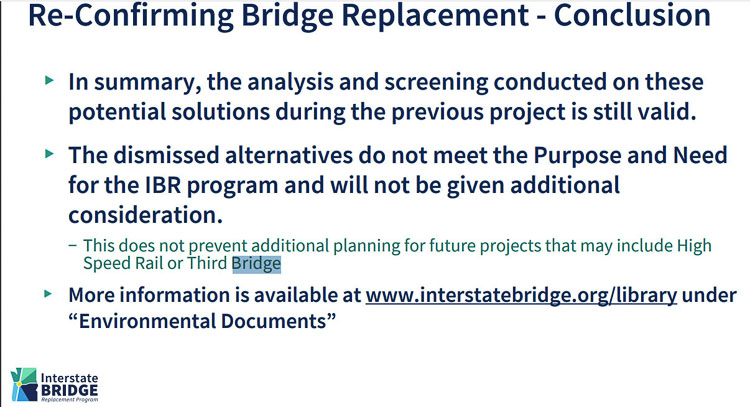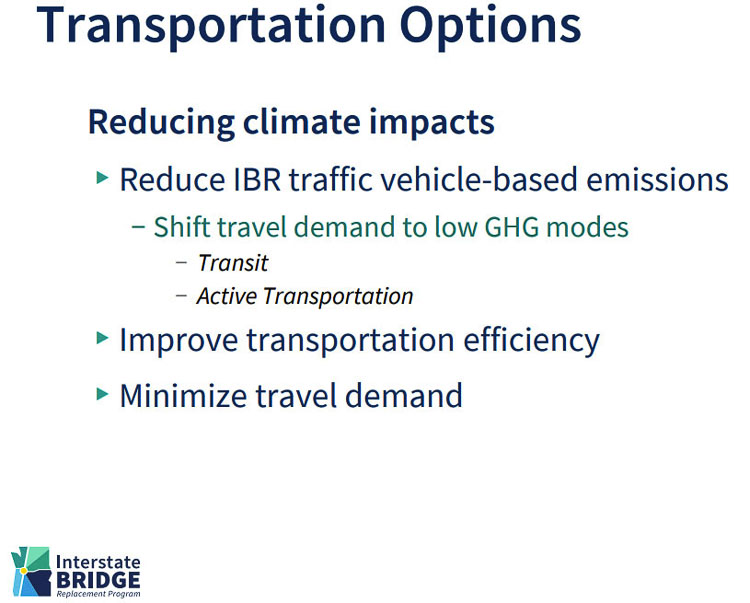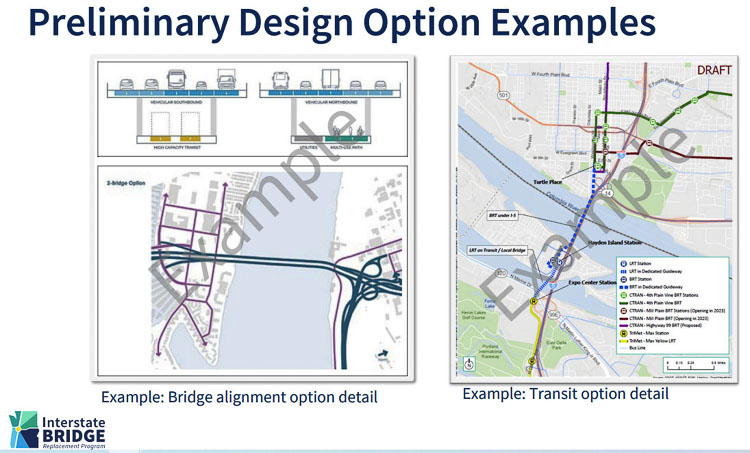Four options off the table as final solution unlikely to deliver improved commute times
The Interstate Bridge Replacement Program (IBRP) team last week eliminated four often discussed proposals for crossings of the Columbia River. The overarching reason — “these four options do not meet Purpose and Need for this program,” said Greg Johnson, program administrator. The decisions were reviewed during a meeting of the Executive Steering Group (ESG) and again at a meeting of the 16 legislators on the Bi-state Bridge Committee.
Johnson emphasized that they are tied to the previous Record of Decision (ROD), and therefore his team has less flexibility in order to avoid going through a new Environmental Impact Statement (EIS) process. The guidelines for the current effort were laid out by Oregon and Washington legislators and memorialized by Governors Jay Inslee and Kate Brown two years ago.
During the meeting with legislators, Johnson responded to a question Oregon Sen. Lew Frederick asked. “How much time will drivers save rather than just saying congestion will be addressed?” He referenced citizens’ dissatisfaction with the one minute improvement in the failed Columbia River Crossing (CRC) effort.

A year ago, Frederick reminded the IBRP team people value their time the most and the one minute. “That is not enough,” he said. “That does not speak to what people want.” He also told them: “we (have to be) able to deal with the bottleneck at the bridge as well as the bottleneck quite frankly, in my district before the bridge. We need to be looking at that as well.”
The answer from Johnson indicated people shouldn’t expect any significant improvement.
“We know that we cannot build our way out of congestion,” he said. “We could build 50 lanes, but at the end of the project, and at the beginning of the project, there are three through lanes in each direction. So building something tremendously bigger and wider, doesn’t solve our problem.”
The discarded proposals were high speed rail, a tunnel, a third bridge in conjunction with a seismic upgrade to the current bridge structures, and the Common Sense Alternative II, were laid out in a 4-page memo. This moves the project forward to what Johnson has said it would be all along — a replacement of the existing bridge structures. He revealed the project would have three through lanes earlier this summer.
“In the end, a replacement bridge was selected as the best solution that met the purpose and need and addressed the six previously identified problems associated with the Interstate Bridge area: growing travel demand and congestion, seismic vulnerability, safety and vulnerability to incidents, impaired freight movement, limited high capacity, transit options for the public, and substandard bicycle and pedestrian facilities.”
The previous ROD and EIS in the CRC were tied to “a light rail project in search of a bridge,” as an Oregon Supreme Court Justice ruled. Being tied to those decisions adds to citizens’ fears this project is nothing but a resurrection of the same light-rail-driven project.
Johnson said they are seeking to answer four key questions by next March.
- What is the mode of high capacity transit?
- How many lanes, both through lanes and auxiliary lanes, will be carried across the bridge and through this corridor?
- Will there be an interchange directly on Hayden Island; either a full interchange or partial interchange? Or will the island be accessed from Marine Drive on a separate, new bridge?
- Will the North Portland Harbor Bridge be replaced or get a seismic retrofit?
Sen. Frederick asked the question most citizens want answered. How much time will drivers save?
“How much time will be changed in terms of the commuting time,” he asked. “How much longer will it take? How much shorter will it be, for people who are coming from Vancouver or going north to Vancouver? Is there any sense of what that might look like, rather than just saying that congestion might be addressed?”
Johnson offered this extensive response.
“This is a five mile stretch in a network of other facilities that are bringing traffic into and taking traffic away from this area. We can solve some issues. And we think the smart way to bring some consistency of travel through this corridor is by having some auxiliary lanes that take those merge weave movements out of the through traffic so that traffic can move unimpeded going forward.
“But we know that we cannot build our way out of congestion, we could build 50 lanes, but at the end of the project, and at the beginning of the project, there are three through lanes in each direction. So building something tremendously bigger and wider, doesn’t solve our problem,
“We have to look at, are we offering mode shift opportunities for folks who want to walk or bike, folks who want to take high capacity transit, and get out of the single occupancy vehicle trips.
“And as you know, Oregon is looking at congestion pricing on both the I-5 corridor south of the bridge, and I-205. Those are things also that will help to address congestion through this corridor.
“Our program itself, we’re five miles in the middle of a vast network of transportation. So I can’t promise you and say that, yeah, this is the magic bullet, and you’re going to be flying through this corridor. But we can make it operate better with some smart investments.”
Bottom line — don’t expect much improvement in commute times.
The region’s major bottleneck and accident site is the two-lane stretch at the Rose Quarter, just five miles south of the project’s “bridge influence area.” Oregon is presently engaged in a battle over their $1.25 billion I-5 Rose Quarter project and how many auxiliary lanes will or won’t be included. They have an $800 million funding shortfall, before a shovel of dirt has been turned.
Legislators expressed a strong desire to receive more information. They are getting questions from constituents they can’t answer. Oregon’s Susan McLain said: “I just wanted to say that I think the theme today has been more information is better.”
Rep. Brandon Vick (Republican, Washington’s 18th District) asked for a spending update — how much has been spent and who the major contractors are that are being paid.
During the climate consideration portion of the presentation, Sarah Ogier IBRP Chief Climate Officer briefed that the program hopes to induce a “mode shift,” where people get out of their cars and ride transit or choose to walk or ride bikes. She also mentioned they have a “zero waste goal for demolition.”
C-TRAN recently announced it was cutting cross-river express bus service roughly in half, due to reduced demand. Oregon Transportation Commissioner Robert Van Brocklin recently said only 4 percent of people in Portland use transit.

Washington Sen. Ann Rivers (Republican, 18th District) wanted to know if they had done updated transit ridership studies, given the significant drop in ridership due to the pandemic and even prior to that. Johnson responded saying, “We are looking at the current ridership. We’re looking at historical trends, as well as projections for future ridership.”
Washington Sen. Lynda Wilson (Republican, 17th District) wanted to make sure the project team was considering the needs of regional freight haulers. She was also hearing rumors of bridge height options and was disappointed the committee wasn’t being briefed on things being considered. She asked for more transparency.
Rep. Paul Harris (Republican, Washington’s 17th District) expressed concerns about the homeless creating a problem if Portland’s MAX light rail was the transit option. He believed it was an environmental concern.
Options dismissed
In describing the four dismissed options, they reported the following. “High speed rail as a transit component to the Interstate Bridge was dismissed during the screening process because it neither increased vehicular capacity nor decreased vehicular demand.”
Will their proposed bridge solution increase vehicle capacity? Johnson’s earlier response says no — just three through lanes plus an unknown number of auxiliary lanes.
Oregon’s current plans to implement tolling on both I-5 and I-205 are designed to decrease vehicle demand, by raising the price of driving a privately owned vehicle on the bridge and on two interstate highways. Johnson has stated multiple times that tolling will be part of the IBRP proposal.
Also dismissed was the Common Sense Alternative II. Jim Howell, a longtime citizen activist and former TriMet bus planner who helped lead opposition to both the Mount Hood Freeway and the Columbia River Crossing, worked with Dave Rowe to offer this creative proposal. It would:
- Scrap most of the highway enlargements that were part of the Columbia River Crossing.
- Build a new eight-lane highway bridge immediately upstream of the current Interstate Bridge.
- Repurpose the Interstate Bridge as a two-lane local street, a light rail crossing and a pair of dedicated cycle tracks.
Howell said the proposal would cost around $1 billion, compared to the CRC’s planned $3.5 billion expenditure. It had the benefit of adding vehicle capacity across the river.

The IBR team found lots of reasons to dismiss the idea, because their focus has been to replace the current two structures.
They believe a repurposed Interstate Bridge would still require bridge lifts for marine traffic. It was estimated adding a lift span to the center of the downstream BNSF rail bridge would eliminate 95 percent of required I-5 bridge lifts. As a “local” bridge, it could carry transit, bikes and pedestrians separated from high speed interstate traffic.
The BNSF rail bridge is old and seismically vulnerable, they say, but that is not in their current purview to fix. Many citizens know the rail firm has already installed a similar lift span on the same rail line, where it crosses the Willamette River about 4 miles to the west.
Repurposing the existing Interstate Bridge would require retrofits to address the roadway safety issues and to bring it up to modern seismic safety standards. These retrofits would not be practically feasible. Citizens might wonder if the interstate no longer travels across a repurposed bridge, why “must” it be brought up to modern seismic safety standards? The Eads bridge in St. Louis is roughly half a century older and is still in use. Washington state has 177 bridges over 100 years old.
500 year seismic event
IBRP team member Chris Regan briefed the legislators that they would design the bridge for a “500 year” seismic event. Clark County Today asked: why a 500-year seismic event? We also asked: “Will you be replacing or upgrading all bridges, i.e. overpasses and underpasses on I-5 in the 5-mile project area, due to seismic issues?”
Raymond Mabey, IBRP assistant program administrator, provided the following response.
“The reference to a 500-year seismic event identifies the possible severity of an earthquake. Standard practice in the industry assumes that a bridge should be built to withstand a moderate level earthquake (500-year event) such that the structure will remain operable. Other standards require a structure to be built to withstand an extreme event (1000-year earthquake).
“The Interstate Bridge replacement will be built to last 100 years and will be built to be seismically resilient. We have not yet established the level of earthquake the structure will be required to withstand, but during the previous project the Interstate Bridge over the Columbia River was required to withstand a 2500-year earthquake (referred to as a maximum credible earthquake).
“A transparent, data-driven process is informing IBR program work, along with input from our partner agencies, stakeholders, and community members. Program work will address all considerations impacting multimodal travelers throughout the 5-mile program area, including earthquake resilience, growing travel demand and congestion, safety, impaired freight movement, limited high-capacity transit options, and substandard bicycle and pedestrian facilities.
“The program will propose replacing the bridges along I-5 that are needed to ensure the IBR solution addresses all the identified transportation needs, and associated structures will be built to modern standards to support a seismically resilient corridor. Many of the structures that will be replaced are necessary to support roadway connections and vehicle mobility as part of the bridge replacement configuration. Other bridges on I-5 itself were built more recently, have stronger foundations, and are made of concrete. All these factors mean they are seismically resilient in their current state so do not need to be replaced to support the identified transportation needs.”
As the meeting ended, legislators said informal “goodbyes”. A minute later TVW staff were overheard saying: “well, it looks like Senator Hobbs is batting 1,000 — he has missed every single meeting.” Senator Steve Hobbs (Democrat, 44th District), is Chairman of the Senate Transportation Committee and one of 8 Washington legislators on the bi-state committee.
Citizens might wonder if he isn’t interested enough in a $3 – $5 billion transportation project to attend any of the meetings and make input, why are we even considering the project at all.




